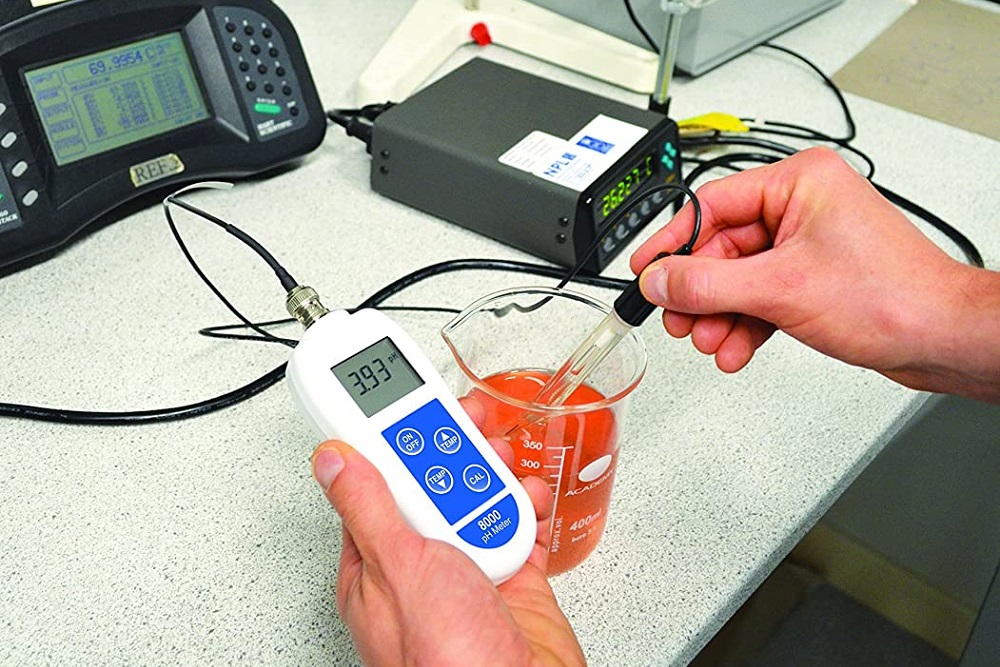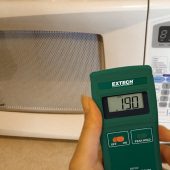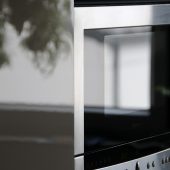All pH meters require regular calibration to remain accurate. Unlike most test tools and meters that need to be sent to the manufacturer for re-calibration, you can calibrate a pH meter yourself.
All you need is a solution with a known pH. This solution is called a pH buffer. The most commonly used calibration solution is a neutral pH 7 buffer.
How to Calibrate a pH Meter with a Buffer Solution

Some pH meters come with one or two buffer solutions included in the kit. In that case, you don’t need to buy anything else to calibrate the meter.
If your meter didn’t come with the buffer or it ran out, you’ll need to buy a new buffer solution. Make sure it’s a pH 7 solution.
Something else you’ll need is distilled water to make the buffer solution (if the buffer is in form of a powder), and to rinse the pH meter. You’ll also need some paper towels to dry the pH probe. If you have access to laboratory wipes such as Kimwipes, even better.
If the buffer is a powder, mix it in a container with distilled water, making sure to follow the instructions on the packet. If it’s a liquid buffer, pour a bit of it in a small cup or container, just enough to cover the pH electrode.
Rinse the electrode on the pH meter with distilled water and wipe dry with a paper towel. Place the pH meter in the pH 7 buffer solution and press the calibrate button. If the display shows a pH of 7, accept the reading. Your pH meter is working correctly.
If the display shows a different reading, adjust the reading (check your user manual on how to do this) until it reads 7.
After calibrating the pH meter, pour out another buffer solution and test the pH meter again (remember to rinse and wipe the electrode). If it calibrated properly, it should read 7. If it does not, repeat the calibration.
2-Point and 3-Point Calibration
The above process is called a 1-point calibration. You calibrate the pH meter just once using a pH 7 buffer. For basic home applications such as an aquarium or hydroponics, a one-point calibration is adequate.
But in sensitive applications such as in an industrial or lab environment, a 2 or 3 point calibration improves the accuracy of the pH meter.
A 2-point application involves calibrating using two buffer solutions: one, a pH 7 solution and the other a pH 4 or pH 10 solution depending on the kinds of solutions you often measure.
If you often measure acidic solutions, use a pH 7 and pH 4 buffer. If you often measure basic solutions, use a pH 7 and pH 10 buffer.
In a 2-point calibration, you repeat the calibration process twice. Rinse and dry the electrode then dip it in the pH 7 buffer (in a small container; don’t dip the pH meter in the buffer bottle). Press calibrate and check the display. Adjust the reading if necessary.
Rinse and dry the electrode probe again then dip it in the pH 4 or pH 10 buffer solution. Press calibrate and check display. Adjust the reading if necessary.
In a 3-point calibration, you repeat the calibration a third time. A 3-point calibration usually consists of pH 4, pH 7 and pH 10 buffers. It’s necessary if you often test acidic and basic solutions.
How to Calibrate a pH Meter Without a Buffer Solution
If you don’t have a buffer solution, you can try making your own DIY pH calibration solution.
However, before you can use a DIY solution, you need to pre-calibrate your pH meter in a store-bought buffer. This ensures it’s properly calibrated. You can then use it to create buffer solutions with the right pH. So you’ll still need to buy pH buffer but only once.
For a pH 7 buffer, add tap water to a container then add 10g of mono potassium phosphate per litre of water. Stir and measure pH. Next add potassium hydroxide (KOH) flake by flake until you get a pH 7 reading.
If you accidentally go beyond 7, add mono potassium phosphate to bring it back to a pH of 7.
For a pH 4 solution, add 20g of citric acid per litre of water. Measure the pH, then slowly add KOH until it reads 4.
Let your buffer solutions rest for about an hour then test them to make sure they’ve stabilised. Label and store them in airtight containers in a dark place.
Note: For sensitive applications where extreme accuracy is required, buy pre-made buffer solutions. Homemade solutions may not calibrate the pH meter accurately and they may not be as stable over time as a store-bought solution.
How Often Should I Calibrate a pH Meter?
This depends on the application environment. In stringent applications like pharmaceuticals, guidelines may recommend calibrating the pH meter before every use.
In less demanding environments like at home, calibrate the pH meter at least once a month.
Other situations that require a re-calibration include;
- When the pH meter or probe is new. Calibrate it before taking any measurements.
- When the probe has not been used in a long time.
- After measuring a strong acidic solution (pH less than 2) or a strong basic solution (pH more than 12).
- Whenever you are suspicious of the readings the pH meter displays.


